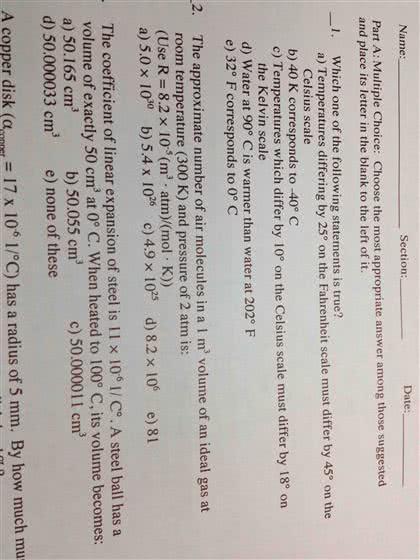PHYS 2001 Lecture 27: PHYS2001_Lecture_27

Nothing can get colder than absolute zero (0 K).
Converting between Kelvin and Celsius: 15.273
C
o
+
=
TT
K
C
K
Celsius Kelvin
Freezing Point 0 oC 273.15 K
Boiling Point 100 oC 373.15 K
Room Temperature 27 oC 300 K
You should read section 12.3 on Thermometers.
12.4 Thermal Expansion
Most solids expand when heated: Heat a thin metal rod, and it expands.
For small changes in temperature
For
small
changes
in
temperature
,
o
LL
∝
Δ
T
L
L
Δ
=
Δ
α
T
L
L
o
Δ
Δ
α
α
is the Coefficient of Linear Expansion.

Units on
α
?[1/
oC] So,
Δ
Tneeds to be in oC
α
is material dependent, i.e. it’s different for steel, aluminum, concrete, etc.
Since the coefficient of linear expansion is different for different materials, this
can lead to thermal stresses in mechanical systems.
D

Example: A steel section of the Alaskan Pipeline had a length of 65 m when it was
installed at a temperature of 18 oC. What is its change in length when the temperature
drops to a frigid -45 oC?
)( ofosteel TTL
−
=
α
TLL oΔ=Δ
α
m -0.049C) 18-C 45)(65)(1012( oo6 =−×=Δ⇒ −
L
The pipe contracts (shrinks) by 4.9 cm.
12.5 Volume Thermal Expansion
Most volumes of materials increase with increases with increasing temperature
Most
volumes
of
materials
increase
with
increases
with
increasing
temperature
.
TVV o
Δ
=
Δ
β
β
= coefficient of volume expansion
Units on
β
?[1/
oC] So,
Δ
Tneeds to be in oC
β
is also material dependent.
Document Summary
Nothing can get colder than absolute zero (0 k). Heat a thin metal rod, and it expands. Is material dependent, i. e. it"s different for steel, aluminum, concrete, etc. Since the coefficient of linear expansion is different for different materials, this can lead to thermal stresses in mechanical systems. Example: a steel section of the alaskan pipeline had a length of 65 m when it was installed at a temperature of 18 oc. Most volumes of materials increase with increases with increasing temperature. At 0 oc, water is an example of one of these. Its volume decreases until 4 oc then it. Its volume decreases until 4 c. then it behaves normally. Thus, water has its greatest density at 4 oc. g y. This causes a lake to freeze in a very specific and serendipitous way. Water near the surface of a lake cools off first, and once its temperature reaches 4 oc, it sinks to the bottom. warmer water.


